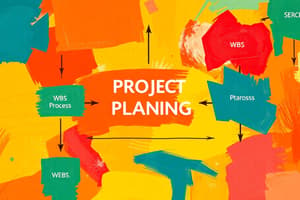Podcast
Questions and Answers
What mainly distinguishes an activity from an event in project planning?
What mainly distinguishes an activity from an event in project planning?
- Events have definable start and finish points, unlike activities.
- Activities consume time, whereas events do not. (correct)
- Activities are always measurable while events are not.
- Activities can be assigned to individuals, but events cannot.
Which characteristic is not associated with an activity?
Which characteristic is not associated with an activity?
- It consumes resources.
- It is measurable.
- It has definable start and finish.
- It is a point in time that does not consume resources. (correct)
Which of the following statements best describes a milestone in project planning?
Which of the following statements best describes a milestone in project planning?
- A milestone consumes both time and resources.
- A milestone is a point in time that does not consume time or resources. (correct)
- A milestone marks the completion of an activity.
- A milestone represents a significant event that consumes resources.
What is an essential purpose of using milestones in project scheduling?
What is an essential purpose of using milestones in project scheduling?
Which one of the following does not represent a characteristic of activities in project management?
Which one of the following does not represent a characteristic of activities in project management?
What is the primary goal of project management?
What is the primary goal of project management?
Which of the following is NOT a project management process?
Which of the following is NOT a project management process?
What key aspect is included in project planning?
What key aspect is included in project planning?
Why is project planning deemed important?
Why is project planning deemed important?
What is one of the questions that must be answered before planning a project?
What is one of the questions that must be answered before planning a project?
What is the primary purpose of a Work Breakdown Structure (WBS)?
What is the primary purpose of a Work Breakdown Structure (WBS)?
Which rule ensures that all work is accounted for in a WBS?
Which rule ensures that all work is accounted for in a WBS?
Which of the following is NOT a criterion for the degree of detail in the WBS?
Which of the following is NOT a criterion for the degree of detail in the WBS?
How should the elements of a WBS be organized?
How should the elements of a WBS be organized?
Which of the following benefits does a well-prepared WBS provide?
Which of the following benefits does a well-prepared WBS provide?
What is the lowest level of a WBS comprised of?
What is the lowest level of a WBS comprised of?
What approach is used to represent the hierarchy of work in a WBS?
What approach is used to represent the hierarchy of work in a WBS?
Which of the following statements about WBS scheduling is true?
Which of the following statements about WBS scheduling is true?
What do constraints in project management primarily signify?
What do constraints in project management primarily signify?
Which type of constraint relates specifically to the availability of materials or equipment?
Which type of constraint relates specifically to the availability of materials or equipment?
Which schedule type is represented by a Gantt chart?
Which schedule type is represented by a Gantt chart?
What type of constraints involves prioritization within the company?
What type of constraints involves prioritization within the company?
Which of the following is NOT a type of constraint mentioned?
Which of the following is NOT a type of constraint mentioned?
Why are targets set in project management?
Why are targets set in project management?
What is the purpose of 'dummy' activities in the Activity-On-Arrow approach?
What is the purpose of 'dummy' activities in the Activity-On-Arrow approach?
Which of the following schedules is specifically utilized for linear projects?
Which of the following schedules is specifically utilized for linear projects?
Flashcards are hidden until you start studying
Study Notes
Project Management
- The process of applying knowledge, skills, tools, and techniques to meet project requirements.
- Project requirements include scope, budget, schedule, quality, resources, risk, safety, and sustainability.
- Project management processes include initiation, planning, controlling, executing, and closing.
Project Planning
- Involves answering questions like "What", "How", "Where", "When", "Who", "How many", and "How much".
- Includes scheduling, team organization, resource allocation, and cost estimation.
- Benefits:
- Deeper exploration of project objectives.
- Reduction of uncertainty.
- Improved efficiency.
- Establishing a baseline for control.
Work Breakdown Structure (WBS)
- A hierarchical diagram illustrating the scope of work.
- Depicts the project from top to bottom, using "parent" and "child" nodes.
- Breaks down "physical" products, deliverables, or work packages into smaller components.
- The highest level is the project itself, and the lowest level comprises construction activities.
WBS Principles
- Follows the 100% rule: All work is considered at every level.
- No overlaps at any level.
- WBS should result in:
- Clearly defined outputs and deliverables for each activity.
- Quality can be monitored through completion criteria.
- The project is broken down to a level suitable for progress tracking.
- Each activity is well-defined and short enough.
Activity and Event
- An activity is a sub-set of the project that consumes time.
- An event is a significant outcome that does not consume time.
- The start and finish of an activity are events.
Milestone
- A significant point in time that does not consume time or resources.
- Used to indicate:
- Accomplishment of work.
- Important reference points.
- Target dates set by the owner or the contractor.
- Payment milestones.
- Project start and completion.
Constraints
- A factor that limits or restricts an activity.
- Dictates the order of activities.
- Can affect a single activity, a group of activities, or the entire project.
Types of Constraints
- Physical: Construction logic, resource availability, safety requirements.
- Financial: Cash flow, tax regulations.
- Environmental: Restrictions and mitigations.
- Management Driven: Prioritization of projects within the company.
- Contractual: Phasing determined by the contract.
- Productivity: Project efficiency.
- Regulatory: Government regulations.
Types of Schedules
- Bar Chart (Gantt): Visual representation of activities and their durations.
- Network Chart:
- Activity on Node (AoN): Activities are represented by nodes, and arrows indicate dependencies.
- Activity on Arrow (AoA): Activities are represented by arrows, and nodes signify events.
- Linear Scheduling: Used for projects with a sequential progression.
Activity On Node (AoN)
- A network diagram where activities are represented as boxes (nodes) and dependencies as lines connecting these nodes.
- Dummy activities represent dependencies without consuming time.
- Events are depicted by circles.
Bar Chart (Gantt Chart)
- A chart that displays activities as horizontal bars.
- The bars represent the duration of the activity.
- Timeline is along the x-axis, and activities are listed on the y-axis.
- Helpful for visual representation of ongoing tasks and scheduling.
Studying That Suits You
Use AI to generate personalized quizzes and flashcards to suit your learning preferences.




